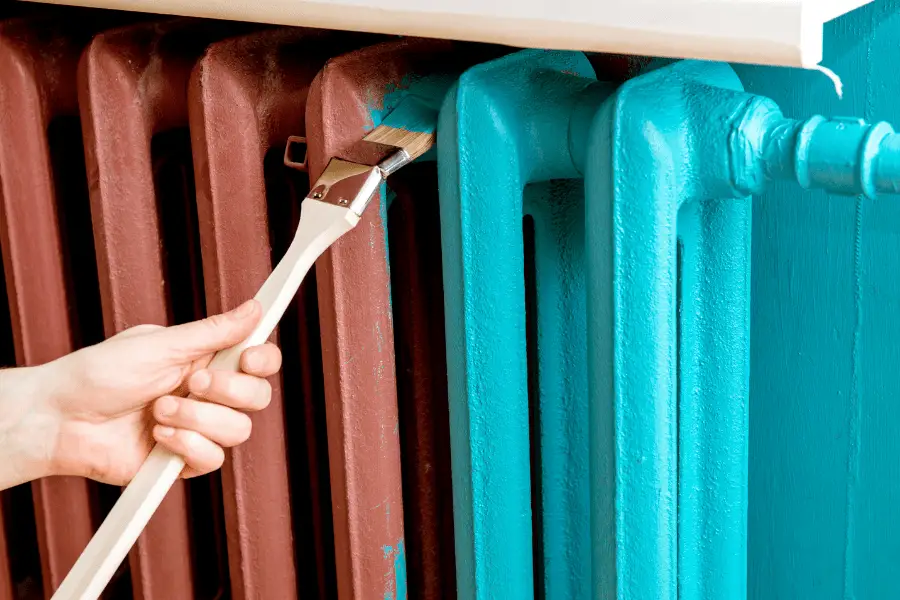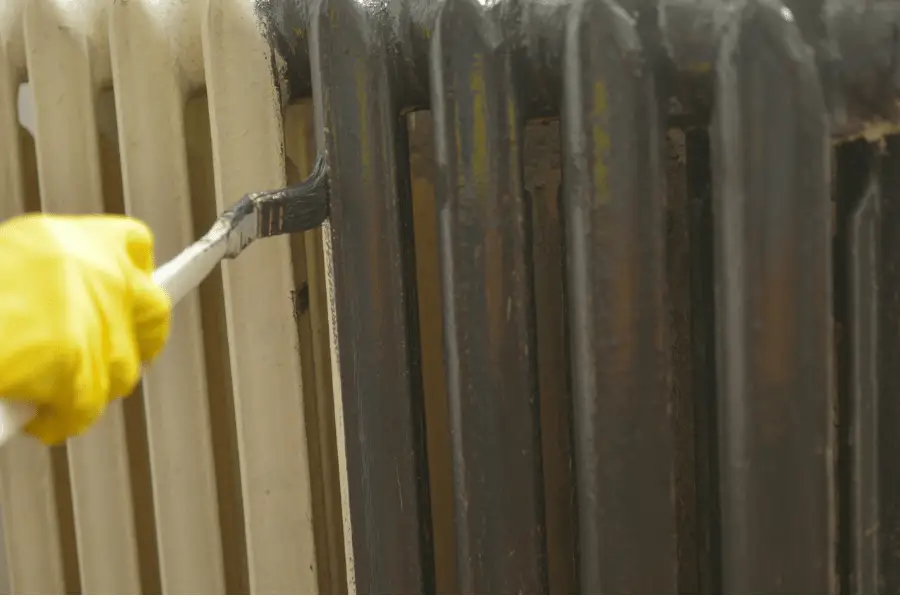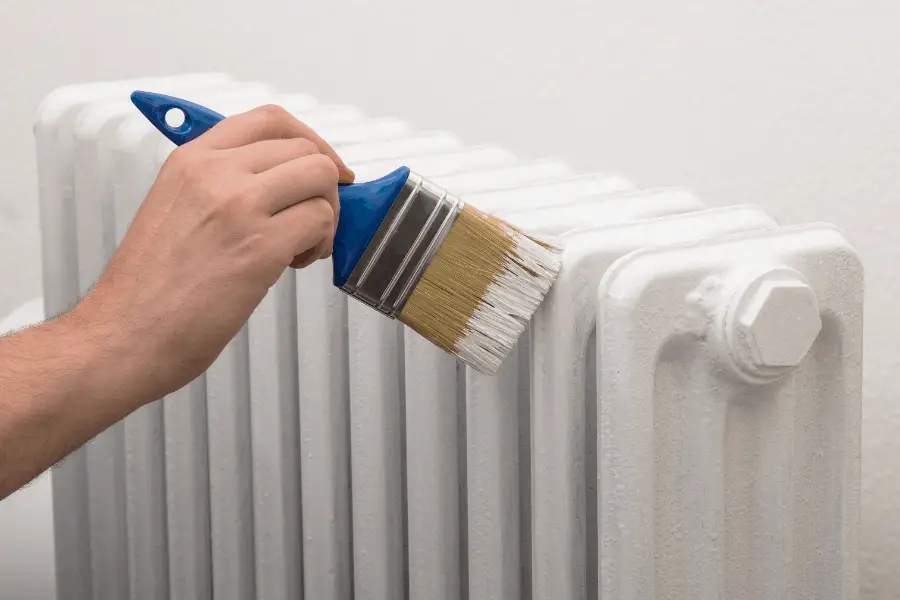If your radiator is looking outdated because the paint chipped or just doesn’t match your home, painting it is an easy solution to this problem. Most radiators are left alone because people don’t think they can be painted.
When radiators are left unpainted, they are a huge eyesore. It can make you dislike that room, or you may even try to hide it behind something. This is less than ideal, as you should be able to feel comfortable in your home. If you didn’t know that you can paint your radiator, now you do!
So, can you use acrylic paint on radiators? Yes! Radiators can be painted with acrylic paint. This makes it incredibly easy to coordinate the color of your radiator, so it matches the room instead of sticking out like a sore thumb. The process is incredibly easy. It is best to paint it before it gets installed, but it is also possible to paint in when it is in place.
How to Paint a Radiator with Acrylic Paint

Before you even start this project, you need to be sure that your radiator is drained and turned off. This will prevent it from running or getting too warm while you are trying to paint. Next, protect your flooring with dust sheets or plastic paint tarp.
If the radiator has been painted previously, you will want to smooth the surface with some sandpaper. This will rough up the current paint and make it easier for your new paint to stick to the surface.
After you finish sanding, clean the radiator to remove any dirt and dust. You can do this with a sponge and soapy water.
If you have a much dirtier radiator, you can use a degreaser to make sure everything comes off the surface. Once you are finished with the degreaser, you will need to wash the surface of the radiator to get rid of any degreaser that is still on the surface.
My favorite and top pick is always Arteza Acrylic Paints. They have so many different colors, and the quality is amazing! I usually use Arteza Paints for all my projects.

If you see any rust spots on the surface of the radiator, you will need to take care of it before you use a primer. If there is just a slight surface of rust, you should be able to get rid of it with some sandpaper. If you notice a large amount of rust, you might want to replace the radiator completely.
Next, you will want to prime the radiator. This is extremely important because it will prevent the paint from staining, peeling, and it will protect the metal radiator from rusting. It will offer a smooth, uniform surface for you to paint over.
I recommend using Mont Marte Acrylic Primer. It offers great coverage, and it’s super affordable!

As you wait for the primer to dry, prepare your paint. Stir it for a few minutes to make sure the pigment is completely mixed in and there are no clumps of darker or thicker color in one spot than the others.
Apply the paint with an angled paint brush. You will want to use thin layers and let each dry properly before adding the next. You should add a minimum of two layers of paint, but you can add more if the color isn’t up to your standards.
It is recommended that you wait at least twenty four hours between paint coats. When you add all of the desired paint coats, leave it to dry for a minimum of 48 hours. To protect your paint job, you will want to finish off with a sealant.
This Krylon Sealer is good to use with acrylic paint. It offer heat resistant protection, as well as flaking, chipping and fading.
Is It Safe to Paint Radiators?
It is completely safe to paint a radiator. If the radiator was made before 1978, there is a potential that is contains lead paint. Before you sand the surface, purchase a lead test kit to see if there is lead in the paint or not. If there is, you absolutely should not sand it. You can call your health department for information on what to do.
Other than the potential of containing lead paint, you don’t have much to worry about with the safety of painting your radiator. As long as you give it plenty of time to dry before using the radiator, usually a day or two, you won’t have any issues.
Do I Need to Prime a Radiator Before Painting?

It is essential that you prime a radiator before painting it. I always use Mont Marte Primer for my acrylic paint projects. It will also protect the radiator from corrosion and rust in the long run, preventing you from having to paint again soon.
It is recommended to apply at least two coats of this primer before you add the paint on top. It will act as a barrier between the radiator and the paint, while allowing the paint to stick to the surface with no issues. Primer is necessary for the best paint job possible.
What is the Best Color to Paint a Radiator?

A common question that is asked before a person paints their radiator is whether or not the color will impact the performance of heat output. Luckily, the color has not shown any connection to improving or decreasing the effectiveness of your radiator.
The best color for your radiator is whatever color you want to paint it. The color will not have any impact on how the radiator emits heat. This means you should be able to paint your radiator whatever color you want without having to trade for less efficient heating.
You can paint your radiator pink, black, white, yellow, blue, purple, and green while getting the same results from each color. The paint will make it easier to look at the radiator, and you don’t have to worry about the heat output being negatively impacted.
How to Seal Acrylic Painted Radiators

In order to protect your paint on the radiator, you will want to add a sealant on top. Just like there is a special primer for radiators, there is also a special sealant that you should use. This special sealer will protect the paint job from the heat it encounters and prevent chipping and peeling.
Applying the sealant is incredibly simple. After you have finished painting your radiator, allow it to completely dry for about 48 hours. You can then apply the sealant in thin, even coats. You should add two coats for the best protection possible.
I recommend using Liquitex Acrylic Varnish on your radiator project. It offers a smooth glossy finish, and prevents your paint from chipping and flaking.

Another popular brand is Krylon. They also protect against chipping, flaking and even UV rays!
Make sure you give the sealant plenty of time to dry between layers. Wait several hours for the first layer to dry before you add the next. When you are finished, allow the sealant to completely dry before you turn the radiator back on. This will prevent exposing the paint to heat too early and causing damage.
Final Thoughts
If you have a radiator in your home that you can’t stand to look at, you are probably wondering if it is possible to paint it to make it look better. The answer is luckily yes, you can paint your radiator, and you can do it with acrylic paint.
Before painting, you will need to clean the radiator and apply a primer. You will then apply the paint and let it dry completely. As soon as the paint is dry, you will want to apply a sealant to protect the paint and prevent you from having to repaint it too soon.
Make sure to follow all my tips and recommended products to ensure your acrylic painted radiator project turns out great! Also, don’t forget to check out my other articles for all your painting Q&A’s. Happy painting!


